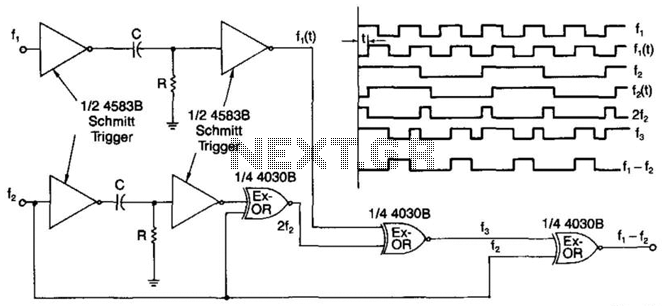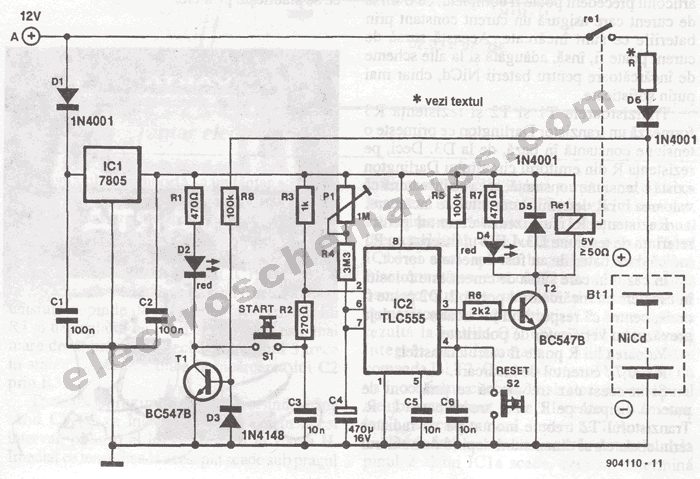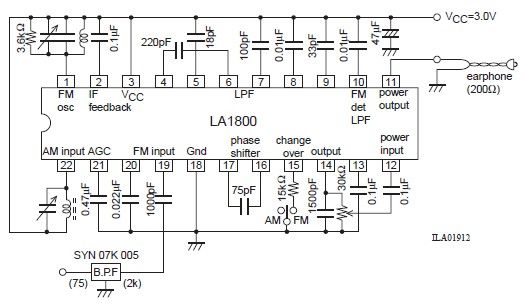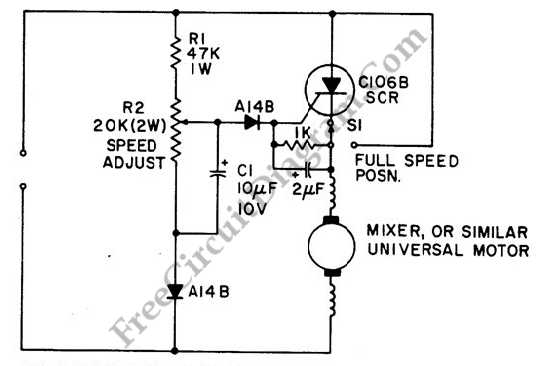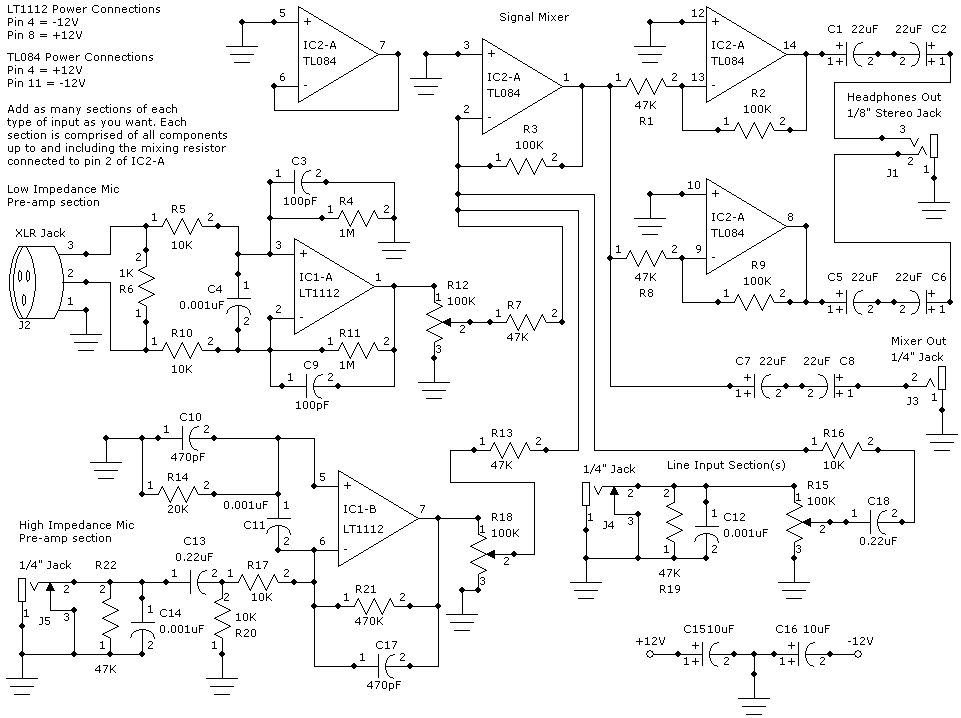
Portable Mixer
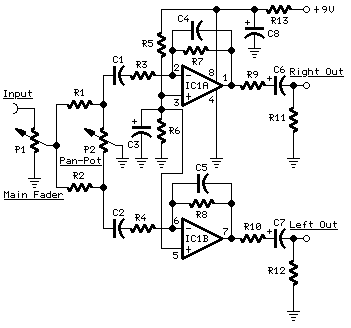
A low noise circuit featuring a variable voltage gain (10 - 100) pre-set, primarily designed for high-quality microphone input, but also suitable for low-level line input. The Tone Control Module consists of a three-band (Bass, Middle, Treble) tone control circuit that maintains unity gain when its controls are set to a flat frequency response. This module can be integrated after one or more Input Amplifier Modules and/or after the Main Mixer Amplifiers. The accompanying block diagram illustrates the entire mixer, which includes four Input Amplifier Modules, four in-out switchable Tone Control Modules, one stereo line input, four mono Main Faders, one stereo dual-ganged Main Fader, four Pan-Pots, a stereo Main Mixer Amplifier Module, and two additional Tone Control Modules that can be switched in and out for each channel before the main left and right outputs. Additional components include a Main on-off SPST switch, a pilot light LED with a 2.2K 1/4W series resistor, DPDT switches for enabling or omitting Tone Control Modules as depicted in the block diagram, input and output connectors of the preferred type, a stereo dual-gang 100K potentiometer for fading the stereo line input, a battery clip for a PP3 9V battery, knobs, and other necessary components.
The circuit design focuses on minimizing noise while providing adjustable gain, making it suitable for various audio applications, particularly in professional audio setups. The variable gain feature allows for flexibility in handling different microphone sensitivities or line levels, ensuring optimal performance across a range of input sources.
The Tone Control Module enhances the audio signal by allowing users to adjust frequency bands independently, which can be crucial for tailoring sound to specific environments or personal preferences. The three-band equalization helps in managing the tonal balance of the audio output, facilitating a more polished sound.
The block diagram provides a clear representation of the system architecture, indicating how each component interacts within the mixer. The inclusion of multiple Input Amplifier Modules allows for the simultaneous processing of several audio sources, while the in-out switchable Tone Control Modules provide further customization options. The layout is designed to streamline the mixing process, with intuitive controls such as the Main Faders and Pan-Pots, which allow for precise adjustments to the audio mix.
The use of a stereo dual-gang 100K potentiometer for the stereo line input ensures smooth fading capabilities, allowing for seamless transitions between audio sources. The pilot light LED serves as a visual indicator of the system's operational status, enhancing user experience. Additionally, the DPDT switches provide the flexibility to bypass the Tone Control Modules when desired, making the system versatile for various applications.
This comprehensive design reflects a well-thought-out approach to audio mixing, incorporating essential features that promote high-quality sound reproduction and user-friendly operation.A low noise circuit equipped with a variable voltage-gain (10 - 100) pre-set, primarily intended as high quality microphone input, also suitable for low-level line input. Tone Control Module: a three-band (Bass, Middle, Treble) tone control circuit providing unity-gain when its controls are set to flat frequency response.
It can be inserted after one or more Input Amplifier Modules and/or after the Main Mixer Amplifiers. The image below shows a Block diagram of the entire mixer featuring four Input Amplifier Modules followed by four in-out switchable Tone Control Modules, one stereo Line input, four mono Main Faders, one stereo dual-ganged Main Fader, four Pan-Pots, a stereo Main Mixer Amplifier Module and two further Tone Control Modules switchable in and out for each channel, inserted before the main Left and Right outputs. To parts listed above should be added: one Main on-off SPST switch, a LED used as pilot-light with its dropping 2K2 1/4W series-resistor, DPDT switches to enable or omit Tone Control Modules as shown in the Block diagram, input and output connectors of the type preferred, one stereo dual-gang 100K potentiometer to fade the Stereo Line Input as shown in the Block diagram, battery clip, PP3 9V battery, knobs etc.
🔗 External reference
The circuit design focuses on minimizing noise while providing adjustable gain, making it suitable for various audio applications, particularly in professional audio setups. The variable gain feature allows for flexibility in handling different microphone sensitivities or line levels, ensuring optimal performance across a range of input sources.
The Tone Control Module enhances the audio signal by allowing users to adjust frequency bands independently, which can be crucial for tailoring sound to specific environments or personal preferences. The three-band equalization helps in managing the tonal balance of the audio output, facilitating a more polished sound.
The block diagram provides a clear representation of the system architecture, indicating how each component interacts within the mixer. The inclusion of multiple Input Amplifier Modules allows for the simultaneous processing of several audio sources, while the in-out switchable Tone Control Modules provide further customization options. The layout is designed to streamline the mixing process, with intuitive controls such as the Main Faders and Pan-Pots, which allow for precise adjustments to the audio mix.
The use of a stereo dual-gang 100K potentiometer for the stereo line input ensures smooth fading capabilities, allowing for seamless transitions between audio sources. The pilot light LED serves as a visual indicator of the system's operational status, enhancing user experience. Additionally, the DPDT switches provide the flexibility to bypass the Tone Control Modules when desired, making the system versatile for various applications.
This comprehensive design reflects a well-thought-out approach to audio mixing, incorporating essential features that promote high-quality sound reproduction and user-friendly operation.A low noise circuit equipped with a variable voltage-gain (10 - 100) pre-set, primarily intended as high quality microphone input, also suitable for low-level line input. Tone Control Module: a three-band (Bass, Middle, Treble) tone control circuit providing unity-gain when its controls are set to flat frequency response.
It can be inserted after one or more Input Amplifier Modules and/or after the Main Mixer Amplifiers. The image below shows a Block diagram of the entire mixer featuring four Input Amplifier Modules followed by four in-out switchable Tone Control Modules, one stereo Line input, four mono Main Faders, one stereo dual-ganged Main Fader, four Pan-Pots, a stereo Main Mixer Amplifier Module and two further Tone Control Modules switchable in and out for each channel, inserted before the main Left and Right outputs. To parts listed above should be added: one Main on-off SPST switch, a LED used as pilot-light with its dropping 2K2 1/4W series-resistor, DPDT switches to enable or omit Tone Control Modules as shown in the Block diagram, input and output connectors of the type preferred, one stereo dual-gang 100K potentiometer to fade the Stereo Line Input as shown in the Block diagram, battery clip, PP3 9V battery, knobs etc.
🔗 External reference
